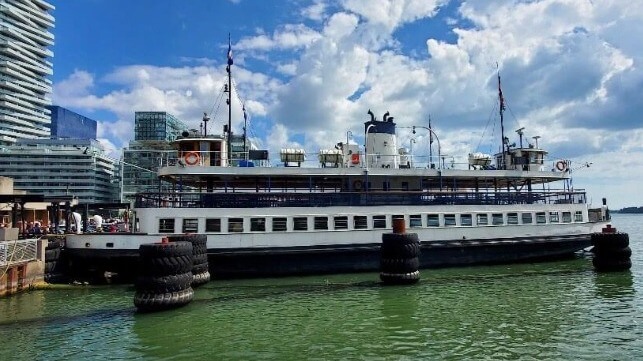High Speed Led to Vintage Ferry Hitting a Dock in Toronto

After analyzing a ferry casualty that injured 20 people in 2022, Canada's Transportation Safety Board has called for more thorough regulation and monitoring of passenger-vessel emergency preparedness.
Exactly two years ago Tuesday, the 1939-built passenger ferry Sam McBride allided with its dock at a terminal in downtown Toronto, Ontario. The force of the impact caused many passengers to fall down, including some who were on or near ladderways at the time of contact. 20 were injured, and six were taken to a hospital for further evaluation and treatment. The vessel suffered minor damage, and the dock required several months of repairs.
Sam McBride was running at full capacity and was behind schedule that day, and the crews were in the habit of speeding up operations under such circumstances, according to TSB. The vessel approached the dock at a speed of about five knots, based on video footage analysis - two knots faster than normal.
Only the aft propeller of the double-ended ferry was turning, and it did not have enough power on its own to reduce speed in time to avert hard contact. The reason for the forward propeller's failure to engage was impossible to determine; the engines were newly-replaced in 2011, and the TSB found no evidence of mechanical failure or control system fault codes, at least on the day of the casualty. The engine OEM found throttle control fault codes dating to June 18, two months before the allision, but none in the timeframe just before the accident. The vessel's systems all functioned as designed in post-casualty sea trials, including in tests designed to simulate the conditions at the time of the allision.
The exact proximate cause of the casualty was not determined, beyond the operational pressures of a busy day and the deck officer's decision to approach at higher-than-normal speed.
In the course of its investigation, TSB reviewed unrelated safety practices aboard Sam McBride, and it found room for improvement. The agency concluded that the abandon-ship plan for Sam McBride was under-staffed: including the captain and engineer, the vessel had only six crewmembers to handle emergency-response duties, launch life rafts and safely disembark 900 passengers. In 2008, Transport Canada had revised the minimum allowable crewing for Sam McBride from 12 down to six at the request of the operator, the City of Toronto. "If the crew complement specified on a vessel’s safe manning document is insufficient to respond to an emergency, there is an increased risk to the safety of the vessel’s crew and passengers," concluded TSB.
Further, "the investigation found no evidence that an exercise including a large number of people representing the vessel’s maximum passenger complement was ever performed," though regular simulated abandon-ship drills were held.
"If passenger evacuation procedures are not validated through a realistic exercise with a representative number of participants, a vessel’s crew will be insufficiently prepared for an emergency and passengers will be at an elevated risk of injury or death," cautioned TSB.
TSB also noted that at the time, the City of Toronto did not have an SMS for its ferry operating division, nor a written procedure for docking maneuvers. Passenger counts were estimated by the crew and were approximate, creating uncertainty about whether all onboard personnel would be accounted for in the event of a casualty.
